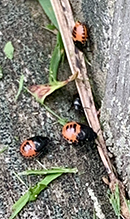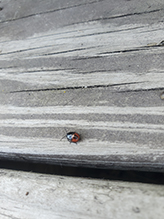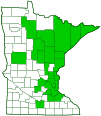White-margined burrower bug
(Sehirus cinctus)
Conservation • Description • Habitat • Ecology • Distribution • Taxonomy
Conservation Status |
|||
| IUCN Red List | not listed |
||
| NatureServe | NNR - Unranked |
||
| Minnesota | not listed |
||
Description |
Sehirinae is a subfamily of burrowing bugs with fifteen genera and many species. They are relatively uncommon. True to their common name, most burrower bugs remain in or on the soil. They are usually found under stones or boards and around the roots of plants. White-margined burrower bug is the only species in the subfamily Sehirinae that occurs in the New World. It occurs in the United States east of the Rocky Mountains, across southern Canada, and in Mexico. It is found in fields, woodlands, lawns, and gardens. Unlike other burrower bugs, white-margined burrower bug is often seen on plants, especially plants in the mint (Lamiaceae) and nettle (Urticaceae) families. It eats the developing seeds of these plants. While it may appear in great numbers, it does not damage the host plant since it eats only the seeds. The body is black, broadly oval, and ⅛″ to ¼″ (4.0 to 6.5 mm) long. The upperside is shiny, hairless, and densely covered with small pits (punctures). The head is small, wider than long, and much narrower than the thorax. It is tucked into a concave groove in the margin of the pronotum. There is no visible “neck” when viewed from above. There are two large, bulging, compound eyes and two small simple eyes (ocelli). There is no crosswise (transverse) groove between the compound eyes. The mouth parts are optimized for piercing and sucking. The antennae are exposed, conspicuous, and long, much longer than the head but not as long as the body. They have five segments. The exoskeletal plate covering the thorax (pronotum) is slightly wider in the rear than the base of the forewings (hemelytra). It is entirely black except for a narrow white border on the lateral margins. The front lateral margins do not have a submarginal row of fine punctures. There are two pairs of wings, and they are held flat over the body when at rest. Between and at the wing bases there is a triangular plate (scutellum). The forewings are as long as the abdomen and completely cover the sides of the abdomen. They have a thickened section at the base and a thin membranous section at the tip with a clear dividing line between the two. The thickened basal part is comprised of a narrow area (clavus) behind the scutellum when the wings are closed, and the remaining broad marginal area (corium). The scutellum is triangular and large. It covers about half of the abdomen, but is not longer than the corium, and does not reach the tip of the abdomen. The clavi do not meet behind the scutellum. Each corium has a thin white border on the lateral margin. Subspecies albonotatus also has a small white spot near the end of the R+M vein. The membranous portion of each hemelytron also has a thin white border on the margin. The white borders on the pronotum, clavi, and hemelytra are what gives this burrower bug its common name. It is the only burrower bug that has this feature. The hindwings are thin, membranous, and completely concealed beneath the forewings. The legs are mostly black. The fourth segment of each leg (tibia) is mostly white on the upper side, black just at the base and tip. The tibiae on the hind leg is armed with rows of strong spines. The last part of the leg (tarsus), corresponding to the foot, has 3 segments. The third segment is distinctly thinner than the first two segments. |
Size |
⅛″ to ¼″ (4.0 to 6.5 mm) |
Similar Species |
Habitat |
Fields, woodlands, lawns, and gardens |
Ecology |
Season |
March to September |
Behavior |
Adults are active at night and will come to lights. |
Life Cycle |
In spring, the female excavates a shallow burrow in the soil, provisions it with seeds, and deposits 120 to 150 eggs. She guards the burrow until the eggs hatch, then continues to care for the young as they develop. Adults overwinter under leaf litter. |
Nymph Food |
Seeds of plants in the mint (Lamiaceae) and nettle (Urticaceae) families |
Adult Food |
Developing seeds of plants in the mint (Lamiaceae) and nettle (Urticaceae) families |
Distribution |
||
|
Sources |
|
| 9/16/2025 | ||
Occurrence |
||
|
||
Taxonomy |
|
Order |
Hemiptera (True bugs, Hoppers, Aphids, and Allies) |
Suborder |
Heteroptera (True Bugs) |
Infraorder |
Pentatomomorpha |
Superfamily |
Pentatomoidea (stink bugs, shield bugs, and allies) |
Family |
Cydnidae (burrowing bugs) |
Subfamily |
Sehirinae |
Genus |
Sehirus |
Subordinate Taxa |
|
white-margined burrower bug (Sehirus cinctus albonotatus) white-margined burrower bug (Sehirus cinctus cinctus) white-margined burrower bug (Sehirus cinctus texensis) |
|
Synonyms |
|
|
|
Common Names |
|
white-margined burrower bug |
|
Glossary
Corium
The thickened basal portion of the front wing that lies between the clavus and the membrane of insects in the family Hemiptera. Plural: coria.
Hemelytron
The forewing of true bugs (order Hemiptera), thickened at the base and membranous at the tip. Plural: hemelytra.
Ocellus
Simple eye; an eye with a single lens. Plural: ocelli.
Pronotum
The exoskeletal plate on the upper side of the first segment of the thorax of an insect.
Scutellum
The exoskeletal plate covering the rearward (posterior) part of the middle segment of the thorax in some insects. In Coleoptera, Hemiptera, and Homoptera, the dorsal, often triangular plate behind the pronotum and between the bases of the front wings. In Diptera, the exoskeletal plate between the abdomen and the thorax.
Tarsus
On insects, the last two to five subdivisions of the leg, attached to the tibia; the foot. On spiders, the last segment of the leg. Plural: tarsi.
Tibia
The fourth segment of an insect leg, after the femur and before the tarsus (foot). The fifth segment of a spider leg or palp. Plural: tibiae.
Visitor Photos
Share your photo of this insect.
This button not working for you?
Simply email us at info@MinnesotaSeasons.com.
Attach one or more photos and, if you like, a caption.
Patty Polkoski |
 |
W D |
 |
never before seen in my garden of 15 yrs., several dozen appeared today looking smaller than a lady bug- with similar orange and black colouring, three horizontal black lines on the defined orange body… Would like to know if they are aphid eaters or if I should keep them away from my roses…they hatched nowhere near the mint and nettles. I was wondering, if like ladybugs, it also eats aphids or strictly mint /nettle seeds? |
Tabitha Kerr |
 |
Armchair Naturalist |
 |
MinnesotaSeasons.com Photos
|

Slideshows
White-margined Burrower Bug (Sehirus cinctus)
Andree Reno Sanborn

Visitor Videos
Share your video of this insect.
This button not working for you?
Simply email us at info@MinnesotaSeasons.com.
Attach a video, a YouTube link, or a cloud storage link.
Other Videos
lots of little bugs in one leaf/Sehirus cinctus also known as the white-margined burrower bug
L board கத்துக்குட்டி
घरों में आने वाला बदबूदार किट:NATURE & WILD JOURNEY
NATURE & WILD JOURNEY
Sehirus cinctus,/ white-margined burrower bug ?
World via Arun lens

Visitor Sightings
Report a sighting of this insect.
This button not working for you?
Simply email us at info@MinnesotaSeasons.com.
Be sure to include a location.
Emilie Longoria
7/3/2025
Location: Plainview, TX
Found pulling weeds from my front lawn.
W D
9/13/2024
Location: Georgian Bay, Ontario zone 4b-5a
never before seen in my garden of 15 yrs., several dozen appeared today looking smaller than a lady bug- with similar orange and black colouring, three horizontal black lines on the defined orange body…
Would like to know if they are aphid eaters or if I should keep them away from my roses…they hatched nowhere near the mint and nettles.
I was wondering, if like ladybugs, it also eats aphids or strictly mint /nettle seeds?
Kameron Baker
9/8/2024
Location: Camden, Tennessee
I have millions of these things in my backyard and they are devouring my wooden playground I never knew they even existed until now.
Roseann
6/25/2023
Location: Cross Lake, Manitoba Canada
At first I thought these were ladybugs but they have 3 horizontal stripes on them. Are they harmful in any way?
John Valo
6/26/2023
White-margined burrower bugs are not harmful to humans or to plants. Both nymphs, which you saw, and adults eat just the seeds of plants in the mint and nettle families.
Sehirus is not an insect to be feared. It doesn’t bite. It won’t damage your garden plants (though it might help control the spread of the henbit in your yard). If it seems like a nuisance, be patient. Its numbers will subside shortly, and it may be years before you notice them again.
— Texas A & M Agrilife Extension
MinnesotaSeasons.com Sightings





